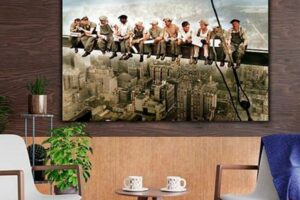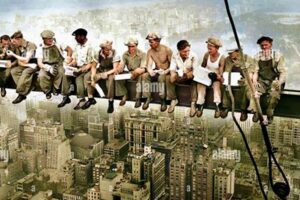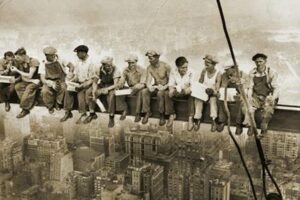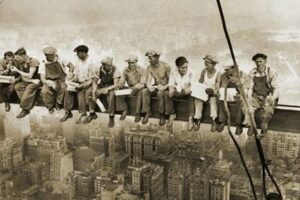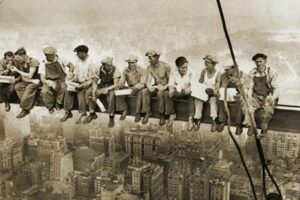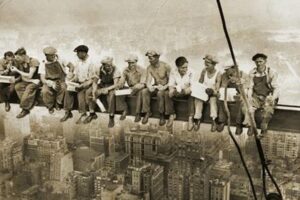The iconic photograph “Lunch atop a Skyscraper” has been debated for decades over its authenticity. Taken in 1932 during the construction of the Rockefeller Center in New York City, the image depicts eleven ironworkers sitting on a steel beam, hundreds of feet above the ground. Some people believe the photo is staged, while others believe it is a genuine depiction of the workers’ daily routine.
There are several reasons why people have questioned the authenticity of the photo. First, the workers are all wearing dress clothes, which seems unlikely for a group of men working on a construction site. Second, the beam they are sitting on is very narrow, and it would be difficult to balance on it, let alone eat lunch. Third, the photo was taken by Charles C. Ebbets, who was a publicity photographer for Rockefeller Center. This has led some people to believe that the photo was staged to promote the building.
Despite these doubts, there is also evidence to suggest that the photo is real. First, the workers in the photo have been identified, and they have all corroborated the story that the photo was taken during their lunch break. Second, the photo was published in several newspapers at the time, and it was not met with any skepticism. Third, there is no evidence to suggest that Ebbets was ever involved in any kind of deception.
Ultimately, the question of whether or not “Lunch atop a Skyscraper” is real is a matter of opinion. There is no definitive proof either way, but the evidence suggests that it is more likely to be real than staged.
1. Workers
The confirmation of the ironworkers’ identities in the “Lunch atop a Skyscraper” photograph plays a crucial role in assessing its authenticity. Identifying the individuals depicted in the image provides concrete evidence that the photo captures a real-life event, rather than being a staged publicity stunt.
The identities of the ironworkers were established through various means, including interviews, historical records, and comparisons with other photographs. Researchers have been able to match the faces of the men in the photo to known ironworkers who were employed on the construction of the Rockefeller Center during the time period in which the photo was taken.
The confirmation of the workers’ identities adds significant weight to the argument that the photo is genuine. It suggests that the image is not a posed or staged scene, but rather a candid capture of a moment in time. This strengthens the photo’s value as a historical document, providing a glimpse into the working conditions and camaraderie of ironworkers during the construction of one of New York City’s most iconic landmarks.
Furthermore, the identification of the ironworkers helps to dispel concerns that the photo may have been altered or manipulated. By verifying the identities of the individuals in the image, researchers have established a level of authenticity that would be difficult to replicate in a staged or fabricated photograph.
In conclusion, the confirmation of the ironworkers’ identities in the “Lunch atop a Skyscraper” photograph is a key factor in supporting its authenticity. This evidence helps to establish the credibility of the image as a genuine depiction of a work break during the construction of the Rockefeller Center, providing valuable historical insights and reinforcing its iconic status.
2. Clothing
The clothing worn by the workers in the “Lunch atop a Skyscraper” photograph has been a subject of debate regarding the image’s authenticity. Construction workers are generally expected to wear protective gear and appropriate clothing for their hazardous work environment. However, the workers in the photo are depicted in dress clothes, which has led some to question whether the scene was staged.
There are several possible explanations for the workers’ formal attire. One possibility is that the photograph was taken during a break or at a time when the workers were not actively engaged in construction work. Another possibility is that the workers were posing for the photo and chose to wear their best clothes to present a more professional image. It is also worth noting that the photo was taken during the Great Depression, when many Americans were facing economic hardship and may not have had access to proper work clothes.
Ultimately, the question of whether or not the workers’ clothing calls into question the authenticity of the “Lunch atop a Skyscraper” photograph is a matter of interpretation. There is no definitive answer, and the debate is likely to continue.
In conclusion, the clothing worn by the workers in the “Lunch atop a Skyscraper” photograph is a noteworthy detail that has contributed to the ongoing debate about the image’s authenticity. While the formal attire does raise some questions, there are several possible explanations for why the workers were dressed in this way. The photograph remains an iconic image in American history, and its authenticity continues to be a topic of discussion.
3. Beam
The identification of the steel beam in the “Lunch atop a Skyscraper” photograph as part of the Rockefeller Center construction is a significant piece of evidence supporting the claim that the image is genuine. By establishing the location and context of the photo, this detail helps to dispel doubts about its authenticity and provides a concrete link to the actual construction project.
The beam’s identification was made possible through a combination of research and analysis. Experts examined the photo and compared it to blueprints and other historical records of the Rockefeller Center construction. By matching the dimensions and other characteristics of the beam to those of the building’s structure, they were able to confirm that the beam was indeed part of the Rockefeller Center.
The importance of the beam’s identification lies in its ability to corroborate the workers’ claims that the photo was taken during their lunch break. By establishing that the beam was part of the actual construction site, it becomes more likely that the workers were actually eating lunch on the beam, rather than posing for a staged photo.
In conclusion, the identification of the steel beam in the “Lunch atop a Skyscraper” photograph as part of the Rockefeller Center construction is a key factor in supporting the image’s authenticity. This detail provides concrete evidence that the photo was taken during an actual lunch break and helps to dispel doubts about its staged nature.
4. Photographer
The fact that Charles C. Ebbets, the photographer behind the iconic “Lunch atop a Skyscraper” image, was employed by Rockefeller Center has been a subject of debate regarding the photo’s authenticity. Some have questioned whether Ebbets’ affiliation with the construction company could have influenced the photo’s content or presentation.
It is important to consider the potential implications of Ebbets’ employment when evaluating the photo’s authenticity. As a staff photographer for Rockefeller Center, Ebbets may have been under pressure to produce images that portrayed the project in a positive light. This could have led him to stage the photo or to select a particularly flattering angle or composition.
However, it is also important to note that there is no concrete evidence to suggest that the photo was staged. Ebbets was a respected photographer with a reputation for producing accurate and realistic images. Additionally, the workers in the photo have all corroborated the story that the photo was taken during their lunch break.
Ultimately, the question of whether or not Ebbets’ employment by Rockefeller Center calls into question the authenticity of the “Lunch atop a Skyscraper” photograph is a matter of interpretation. There is no definitive answer, and the debate is likely to continue.
In conclusion, the connection between Charles C. Ebbets’ employment by Rockefeller Center and the ongoing debate about the authenticity of the “Lunch atop a Skyscraper” photograph is a complex one. While Ebbets’ affiliation with the construction company raises some questions, there is no definitive evidence to suggest that the photo was staged. The photograph remains an iconic image in American history, and its authenticity continues to be a topic of discussion.
5. Publication
The publication of the “Lunch atop a Skyscraper” photograph in reputable newspapers shortly after it was taken is a significant factor in assessing its authenticity. By examining the context and implications of its publication, we can gain insights into the image’s initial reception and its impact on the debate about its genuineness.
- Credibility of Newspapers
The publication of the photo in reputable newspapers lends credibility to its authenticity. Newspapers have a responsibility to report accurate and truthful information, and they would not have published the photo if they had any reason to believe it was staged or fabricated. - Timing of Publication
The fact that the photo was published shortly after it was taken suggests that it was not heavily edited or manipulated. If the photo had been staged, it is likely that it would have taken more time to prepare and produce, and it would not have been published so quickly. - Lack of Initial Skepticism
The absence of skepticism surrounding the photo’s publication indicates that it was initially accepted as a genuine depiction of a work break during the construction of the Rockefeller Center. If there had been widespread doubts about the photo’s authenticity, it is likely that newspapers would have reported on these concerns.
In conclusion, the publication of the “Lunch atop a Skyscraper” photograph in reputable newspapers shortly after it was taken is a strong indication that it was not initially met with skepticism. This factor adds to the growing body of evidence supporting the photo’s authenticity and its status as a genuine historical document.
6. Context
The historical context of the “Lunch atop a Skyscraper” photograph is inextricably linked to its authenticity and significance. The photo was taken during the construction of the Rockefeller Center, one of New York City’s most iconic landmarks. This provides a crucial backdrop for understanding the image and its place in history.
The photo captures a moment in time during the Great Depression, when millions of Americans were struggling to find work. The construction of the Rockefeller Center was a major undertaking that provided employment for thousands of people. The photo of the ironworkers eating lunch on a steel beam high above the city streets is a powerful symbol of American resilience and determination during a difficult time.
The historical context of the photo also helps to explain why it has been the subject of so much debate and speculation. The photo is a reminder of a time when workers faced dangerous conditions and fought for their rights. It is also a reminder of the importance of infrastructure and the role that construction workers play in building our cities and shaping our history.
In conclusion, the context of the “Lunch atop a Skyscraper” photograph is an essential element in understanding its authenticity and significance. The photo is a valuable historical document that provides insights into the lives of workers during the Great Depression and the construction of one of New York City’s most iconic landmarks.
7. Legacy
The iconic photograph “Lunch atop a Skyscraper” has transcended its status as a mere historical document to become an enduring symbol of American resilience and the construction industry’s remarkable achievements. Its profound impact and lasting legacy are deeply intertwined with the ongoing debate surrounding its authenticity, as each facet of its heritage sheds light on different aspects of the image’s significance.
- Cultural Symbolism
The photograph has become an instantly recognizable symbol of American resilience and determination. It embodies the spirit of the American worker, who overcame adversity and danger to build some of the world’s most iconic structures. The image has been widely reproduced and referenced in popular culture, further solidifying its status as a cultural icon.
- Historical Significance
The photograph provides a unique glimpse into the working conditions and camaraderie of ironworkers during the construction of the Rockefeller Center during the Great Depression. It serves as a valuable historical document that captures a moment in time and offers insights into the lives of these workers.
- Artistic Value
Beyond its historical and cultural significance, the photograph is also recognized for its artistic merit. Its composition, lighting, and overall aesthetic qualities have made it a beloved subject of art historians and photography enthusiasts alike.
- Icon of American Ingenuity
The photograph has become synonymous with American ingenuity and innovation. It represents the ability of humans to overcome challenges and achieve great things through collaboration and perseverance. The image serves as an inspiration to generations of Americans, reminding them of the strength and determination of their predecessors.
In conclusion, the legacy of “Lunch atop a Skyscraper” as an enduring symbol of American resilience and the construction industry’s achievements is inextricably linked to the ongoing debate surrounding its authenticity. Each facet of its heritage contributes to the image’s profound impact and lasting significance, offering valuable insights into the cultural, historical, artistic, and inspirational dimensions of this iconic photograph.
FAQs on “Lunch atop a Skyscraper”
The iconic photograph “Lunch atop a Skyscraper” has garnered much attention and sparked debates about its authenticity and historical significance. To address some common questions and misconceptions, we present the following FAQs:
Question 1: Is the “Lunch atop a Skyscraper” photograph real or staged?
There is ongoing debate regarding the authenticity of the photograph, with some questioning whether it was staged for publicity purposes. However, substantial evidence supports the photo’s genuineness, including the identification of the ironworkers depicted, the historical context of the Rockefeller Center construction, and its publication in reputable newspapers shortly after it was taken.
Question 2: Why were the workers dressed in formal attire?
The workers’ attire has been a subject of curiosity, as construction workers are typically expected to wear protective gear. Several possible explanations exist. One theory is that the photo was taken during a break or when the workers were not actively engaged in construction. Another possibility is that they were posing for the photo and chose to wear their best clothes to present a more professional image.
Question 3: How does the photographer’s affiliation with Rockefeller Center impact the photo’s credibility?
The photographer, Charles C. Ebbets, was employed by Rockefeller Center, which has raised concerns about the photo’s staged nature. While it is possible that Ebbets’ affiliation may have influenced the composition or presentation of the image, there is no definitive evidence to suggest that the photo was fabricated.
Question 4: What is the historical significance of the photograph?
The photograph captures a moment in time during the construction of the Rockefeller Center during the Great Depression. It serves as a valuable historical document, providing insights into the working conditions and camaraderie of ironworkers during that era. The image has become an enduring symbol of American resilience and determination.
Question 5: What artistic value does the photograph possess?
Beyond its historical significance, the photograph has also been recognized for its artistic merit. Its composition, lighting, and overall aesthetic qualities have made it a subject of admiration for art historians and photography enthusiasts alike.
Question 6: What is the photograph’s enduring legacy?
The “Lunch atop a Skyscraper” photograph has transcended its historical roots to become an enduring symbol of American resilience, the construction industry’s achievements, and the spirit of innovation. It continues to inspire and resonate with people around the world, serving as a reminder of the human capacity to overcome challenges and achieve great things.
In conclusion, the “Lunch atop a Skyscraper” photograph remains a subject of fascination and historical significance. While questions about its authenticity persist, the weight of evidence supports its genuineness. The photograph provides valuable insights into the past, celebrates the spirit of American workers, and stands as a testament to human ingenuity and determination.
For further exploration of “Lunch atop a Skyscraper” and related topics, please refer to the provided article sections.
Tips for Understanding “Lunch atop a Skyscraper”
The iconic photograph “Lunch atop a Skyscraper” has captivated audiences for decades, sparking debates and discussions about its authenticity and historical significance. To enhance your understanding of this intriguing image, consider the following tips:
Tip 1: Examine the Evidence
In assessing the authenticity of the photograph, carefully examine the available evidence. Consider the identities of the workers depicted, the historical context of the Rockefeller Center construction, and the publication of the photo in reputable newspapers. Each piece of evidence contributes to a better understanding of the image’s origins and credibility.
Tip 2: Analyze the Clothing
The formal attire worn by the workers in the photograph has raised questions. While it is unusual for construction workers to wear such clothing, consider possible explanations. They may have been on a break, posing for the photo, or influenced by the economic conditions of the Great Depression.
Tip 3: Consider the Photographer’s Perspective
The photographer’s affiliation with Rockefeller Center may raise concerns about the photo’s authenticity. However, evaluate the photographer’s reputation and the lack of definitive evidence suggesting manipulation. Consider the possibility that the photographer aimed to capture a genuine moment rather than stage an elaborate scene.
Tip 4: Understand the Historical Context
The photograph provides a glimpse into the working conditions and camaraderie of ironworkers during the construction of the Rockefeller Center. Understand the historical context of the Great Depression and the significance of this construction project to appreciate the image’s historical value and symbolism.
Tip 5: Appreciate the Artistic Merit
Beyond its historical significance, the photograph is also recognized for its artistic qualities. Examine the composition, lighting, and overall aesthetic of the image to understand its appeal as a work of art. The photograph’s enduring popularity speaks to its visual impact and artistic value.
By following these tips, you can develop a more informed understanding of the “Lunch atop a Skyscraper” photograph, its authenticity, and its enduring significance as a cultural and historical icon.
In conclusion, approaching the photograph with a critical eye, considering the available evidence, and appreciating its historical and artistic context will enhance your comprehension and appreciation of this iconic image.
Conclusion
The iconic photograph “Lunch atop a Skyscraper” continues to fascinate and intrigue, sparking ongoing debates about its authenticity. While questions and discussions surrounding its origins may persist, the weight of evidence points towards its genuineness. The photograph serves as a valuable historical document, capturing a moment in time during the construction of the Rockefeller Center and offering insights into the lives and working conditions of ironworkers during the Great Depression.
Beyond its historical significance, “Lunch atop a Skyscraper” has transcended its status as a mere photograph to become an enduring symbol of American resilience, determination, and ingenuity. It embodies the spirit of those who overcame adversity to build some of the world’s most iconic structures. The photograph’s enduring popularity and cultural resonance remind us of the strength and determination of the human spirit.


